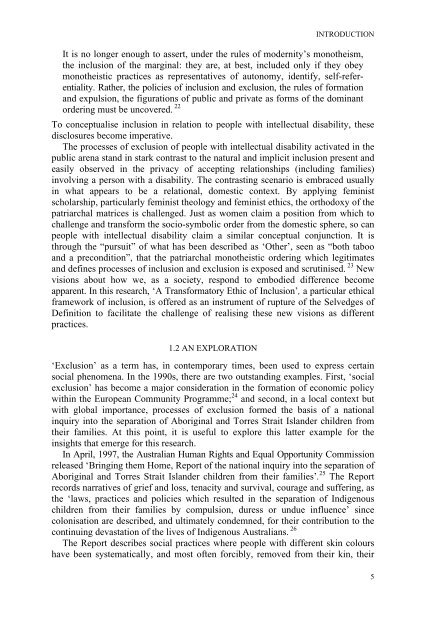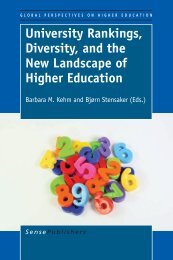Rupturing Concepts of Disability and Inclusion
Rupturing Concepts of Disability and Inclusion
Rupturing Concepts of Disability and Inclusion
You also want an ePaper? Increase the reach of your titles
YUMPU automatically turns print PDFs into web optimized ePapers that Google loves.
INTRODUCTION<br />
It is no longer enough to assert, under the rules <strong>of</strong> modernity’s monotheism,<br />
the inclusion <strong>of</strong> the marginal: they are, at best, included only if they obey<br />
monotheistic practices as representatives <strong>of</strong> autonomy, identify, self-referentiality.<br />
Rather, the policies <strong>of</strong> inclusion <strong>and</strong> exclusion, the rules <strong>of</strong> formation<br />
<strong>and</strong> expulsion, the figurations <strong>of</strong> public <strong>and</strong> private as forms <strong>of</strong> the dominant<br />
ordering must be uncovered. 22<br />
To conceptualise inclusion in relation to people with intellectual disability, these<br />
disclosures become imperative.<br />
The processes <strong>of</strong> exclusion <strong>of</strong> people with intellectual disability activated in the<br />
public arena st<strong>and</strong> in stark contrast to the natural <strong>and</strong> implicit inclusion present <strong>and</strong><br />
easily observed in the privacy <strong>of</strong> accepting relationships (including families)<br />
involving a person with a disability. The contrasting scenario is embraced usually<br />
in what appears to be a relational, domestic context. By applying feminist<br />
scholarship, particularly feminist theology <strong>and</strong> feminist ethics, the orthodoxy <strong>of</strong> the<br />
patriarchal matrices is challenged. Just as women claim a position from which to<br />
challenge <strong>and</strong> transform the socio-symbolic order from the domestic sphere, so can<br />
people with intellectual disability claim a similar conceptual conjunction. It is<br />
through the “pursuit” <strong>of</strong> what has been described as ‘Other’, seen as “both taboo<br />
<strong>and</strong> a precondition”, that the patriarchal monotheistic ordering which legitimates<br />
<strong>and</strong> defines processes <strong>of</strong> inclusion <strong>and</strong> exclusion is exposed <strong>and</strong> scrutinised. 23 New<br />
visions about how we, as a society, respond to embodied difference become<br />
apparent. In this research, ‘A Transformatory Ethic <strong>of</strong> <strong>Inclusion</strong>’, a particular ethical<br />
framework <strong>of</strong> inclusion, is <strong>of</strong>fered as an instrument <strong>of</strong> rupture <strong>of</strong> the Selvedges <strong>of</strong><br />
Definition to facilitate the challenge <strong>of</strong> realising these new visions as different<br />
practices.<br />
1.2 AN EXPLORATION<br />
‘Exclusion’ as a term has, in contemporary times, been used to express certain<br />
social phenomena. In the 1990s, there are two outst<strong>and</strong>ing examples. First, ‘social<br />
exclusion’ has become a major consideration in the formation <strong>of</strong> economic policy<br />
within the European Community Programme; 24 <strong>and</strong> second, in a local context but<br />
with global importance, processes <strong>of</strong> exclusion formed the basis <strong>of</strong> a national<br />
inquiry into the separation <strong>of</strong> Aboriginal <strong>and</strong> Torres Strait Isl<strong>and</strong>er children from<br />
their families. At this point, it is useful to explore this latter example for the<br />
insights that emerge for this research.<br />
In April, 1997, the Australian Human Rights <strong>and</strong> Equal Opportunity Commission<br />
released ‘Bringing them Home, Report <strong>of</strong> the national inquiry into the separation <strong>of</strong><br />
Aboriginal <strong>and</strong> Torres Strait Isl<strong>and</strong>er children from their families’. 25 The Report<br />
records narratives <strong>of</strong> grief <strong>and</strong> loss, tenacity <strong>and</strong> survival, courage <strong>and</strong> suffering, as<br />
the ‘laws, practices <strong>and</strong> policies which resulted in the separation <strong>of</strong> Indigenous<br />
children from their families by compulsion, duress or undue influence’ since<br />
colonisation are described, <strong>and</strong> ultimately condemned, for their contribution to the<br />
continuing devastation <strong>of</strong> the lives <strong>of</strong> Indigenous Australians. 26<br />
The Report describes social practices where people with different skin colours<br />
have been systematically, <strong>and</strong> most <strong>of</strong>ten forcibly, removed from their kin, their<br />
5














